ISC Biology Previous Year Question Paper 2011 Solved for Class 12
Part-I
(Attempt All Questions)
Question 1.
(a) Mention one significant difference between each of the following : [5]
(i) Growth and Development
(ii) Muscle twitch and Tetanus
(iii) Heartwood and Sapwood
(iv) Leghaemoglobin and Haemoglobin
(v) Collateral vascular bundle and Concentric vascular bundle.
(b) Give reasons for the following : [5]
(i) Adrenaline is referred to as emergency hormone.
(ii) Despite availability of plenty of water, leaves of certain plants wilt during the day and recover in the evening.
(iii) Hybrid seeds should be raised every year.
(iv) The wing of a bat is said to be homologous to the wing of a bird and analogous to the wing of an insect.
(v) Symptoms of deficiency of certain nutrients appear in the old leaves first.
(c) Give scientific terms for each of the following : [5]
(i) The development of more than one embryo in a seed.
(ii) The process of growing old.
(iii) Method of inducing early flowering in plants by pre-treatment of their seeds at lower temperatures.
(iv) Determination of the age of a tree by counting the number of annual rings.
(v) The type of growth in which the volume of the body increases without the increase in the number of body cells.
(vi) A condition when the muscles deteriorate and the person becomes invalid.
(d) Mention the most significant function of each of the following : [3]
(i) Fovea centralis
(ii) Lymphocytes
(iii) Bundle of His
(iv) Calyptra
(v) Bulliform cells
(vi) Quiescent centre
(e) State the best-known contribution of the following scientists : [2]
(i) Ernst Haeckel
(ii) Carl Landsteiner
(iii) Robert Koch
(f) Expand the following :
(i) Hensen [2]
(ii) G-6PD
(ii) DPD
(iii) MRI
(iv) SAN
Answer:
(a) (i)
| Growth | Development |
| Growth is the irreversible increase in dry weight, mass or volume of a cell, organ or organism. | Development is the sequence of events that occur in the life history of a cell, organ or organism which includes growth, differentiation, maturation and senescence. |
(ii)
| Muscle twitch | Tetanus |
| A muscle twitch is the single isolated contraction of the muscle libre by a single nerve impulse or by a single electric shock of adequate strength, followed by immediate relaxation. | Tetanus is the continued state of contraction of a muscle fibre stimulated by many nerve impulses or electric shocks. Contraction remains until the stimulation continues. |
(iii)
| Heartwood | Sapwood |
| Heartwood (duramen) is the inner dark coloured, non-functional secondary xylem. | Sapwood (alburnum) is the outer, light-coloured, functional secondary xylem in most of the old dicot trees. |
(iv)
| Leghaemoglobin | Haemoglobin |
| Leghaemoglobin is the pinkish pigment present in the cells of root nodules of leguminous plants and acts as an oxygen scavenger to protect the nitrogen-fixing enzyme nitrogenase of the bacteroids. | Haemoglobin is the blood pigment meant for transport of oxygen and regulates other things as carbon dioxide, nitric oxide, etc. |
(v)
| Collateral vascular bundle | Concentric vascular bundle |
| Collateral vascular bundles are those conjoint bundles (contain both xylem and phloem) in which both phloem and xylem lie on same radius, with phloem on the outer side and xylem towards the inner side. | Concentric vascular bundles have one type of vascular tissue (xylem or phloem) forms a solid core while the other surrounds it completely on all sides. |
(b)
(i) Adrenaline is referred to as emergency hormone because it prepares the animal to meet any emergency condition by flight or fight reactions i.e., by running away (flight) to safety, or by giving a tough fight to the enemy (fight reaction). It increases the heart rate, blood pressure, blood sugar level, blood supply to muscles and brain etc.
(ii) Leaves of certain plants wilt during the day because the rate of transpiration is much higher than the rate of water absorption by the roots. As in the evening, the rate of transpiration decreases the plants regain their turgidity in the evening and recover.
(iii) The plants raised from the hybrid seeds show segregation of characters and do not maintain hybrid character necessitating the need to produce hybrid seeds every year.
(iv) The wing of a bat is homologous to the wing of the birds because both have the same basic plan of organisation and are modified forelimbs having different shapes, adapted for different habitats whereas it is analogous to the wing of an insect. The basic structure of the wing of insect is different from the wing of a bat. However, their function is similar. The deficiency symptoms of certain nutrients appear in the old leaves first because they are mobile and required in large detectable quantities for the synthesis of organic molecules. Polyembryony
(c)
(i) Polyembryony
(ii) Ageing (Senescence)
(iii) Vernalisation
(iv) Dendrochronology
(v) Auxetic growth
(vi) Duchenne’s Muscular Dystrophy (t)MD)
(d)
(i) It has only cone cells and is the place of most distinct vision.
(ii) A type of white blood cells, meant for eliminating the antigen (microbes and their toxins) by releasing antibodies. These are B and T-lymphocytes.
(iii) It is a bundle of heart-muscles that fapidly transmit the cardiac impulse received from Ay node to all parts of the ventricles causing them to contract.
(iv) Calyptra is a cone shaped structure that covers the root-tips and develops as a result of cclidivision by the meristem called calyptrogen in monocot roots.
(v) Bulliform cells are large thin walled protruding epidermal cells present on the upper epidermis of leaves of many grasses. They lose water and become flaccid and help to roll up leaves to reduce the exposed surface in case of water deficiency.
(vi) Quiescent centre is present in the centre of root-apex and functions as reserve meristem. Here divisions are very few. They can survive stress and provide cells to a regenerating meristem and helps in the recovery of roots after irradiation.
(e)
(1) Ernst Haeckel proposed biogenetic law which states that ‘Ontogeny repeats phylogeny’.
(ii) Karl Landsteiner discovered ABO blood groups in human beings.
(iii) Robert Koch (1843-1910) German physician contributed much to the field of microbiology and infectious diseases. He was the first to discover tuberculosis bacterium. He proposed Koch’s postulates which state certain requirements should be fulfilled if the disease causing character of any organism is to be proved.
(iv) Hensen discovered the disease leprosy, proposed the sliding theory of muscle contraction.
(f)
(i) Glucose – 6 phosphate dehydrogenase.
(ii) Diffusion Pressure Deficit
(iii) Magnetic Resonance Imaging
(iv) Sino-Atrial Node
Part-II
Section – A
(Attempt Three Questions)
Question 2.
(a) What are guard cells ? Explain their role in regulating transpiration. [4]
(b) Explain tunica corpus theory of origin of shoot apex. [3]
(c) Give one function and one deficiency symptom of each of the following in plants : [3]
(i) Magnesium
(ii) Calcium
(iii) Molybdenum
Answer:
(a) The guard cells are two small, specialised green epidermal cells surrounding a stomata. They are kidney-shaped in dicot plants and dumb-bell shaped in cereals/monocot plants. The expansion and contraction of thin-walled sides/ends of guard cells regulate the opening and closure move-ments.
Mechanism of Stomatal Movement: Stomata function as turgor operated valves because their opening and closing movement is governed by turgor changes of the guard cells. Whenever, the guard cells swell up due to increased turgor, a pore is created between them. With the loss of turgor the stomatal pores are closed. Stomata generally open during the day and close during the night with a few exceptions. The important factors which govern the sotmatal opening are light, high pH or reduced CO2 and availability of water. The opposite factors govern stomatal closure, viz., darkness, lowpR or high CO2 and dehydration.
(b) According to tunica-corpus theory of Schmidt (1924), the shoot apex has two parts, outer mantle like tunica and inner cellular mass known as corpus (Fig). Cells of tunica are small. They undergo anticlinal divisions and, therefore, take part in surface growth. Cells derived from tunica give rise to epidermis of both stem as well as leaves. If tunica is more than one layer in thickness, the outer layer differentiates into epidermis while ‘ the inner layers contribute to the formation of leaf interior and cortial tissues.
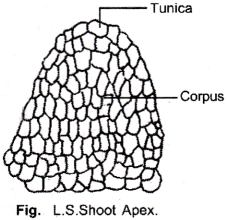
Cells of corpus are comparatively larger. They divide in different planes. Cells derived from corpus form procambium and ground meristem. Procambium is slow to differentiate. Initially its cells are narrow, elongated and densely cytoplasmic. They occur in parallel files. Procambium gives rise to primary phloem, primary xylem and intrafascicular cambium between the two (in case of dicots and gymnosperms). Ground meristem differentiates into pith in the centre and pericycle, endodermis, cortex and hypodermis respectively towards the outer side.
(c)
| Element | Function | Deficiency Symptom |
| (i) Magnesium | Chlorophyll formation | Interveinal chlorosis with anthocyanin pigmentation |
| (ii) Calcium | Meristematic activity i.e., cell divisions connected with chromosome formation | Stunted growth, degeneration of meristem |
| (iii) Molybdenum | Nitrogen metabolism | Mottled chlorosis with marginal necrosis, the upper half of lamina fall down (whiptail disease) |
Question 3.
(a) Describe the development of female gametophyte in Angiosperms.
(b) Explain the mass flow hypothesis of transport of food.
(c) Differentiate between cyclic and non-cyclic photophosphorylation
Answer:
(a) One hypodermal nucellar cell of the micropylar region differentiates as the sporogenous cell. It forms a diploid megaspore mother cell or megasporocyte. The megaspore mother cell undergoes meiosis (Megasporogenesis) and forms a row of four haploid megaspores. Only the chalazal megaspore remains functional while the other three degenerate. The functional megaspore enlarges and gives rise to female gametophyte, also called embryo-sac. It lies in the micropylar area of the nucellus.
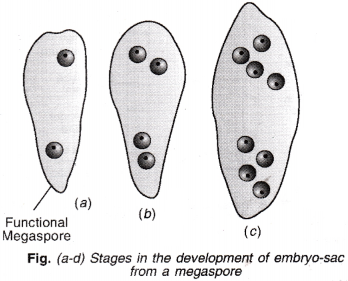
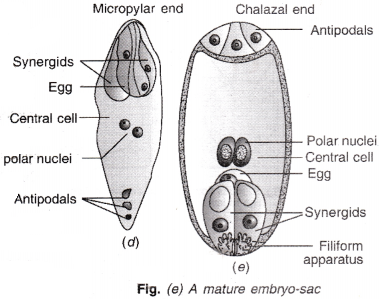
Micropylar end Chalazal end Functional megaspore divides by three mitotic divisions to form 8-nucleate, or 7-celled embryo- sac (= female gametophyte). The development of female gametophyte from megaspore is called Megagametogenesis. The development of embryo-sac in angiosperms is generally Monosporic i. e., embryo-sac develops from a uninucleate megaspore.
Embryo sac is an oval multicellular structure. It is covered over by a thin membrane derived from the parent megaspore wall. The typical or Polygonum type of embryo sac (Fig.) contains 8 nuclei but 7 cells – 3 micropylar, 3 chalazal and one central. The three micropylar cells are collectively known as egg apparatus. They are pyriform in outline and are arranged in a triangular fashion. One cell is larger and is called egg or oosphere. The remaining two cells are called synergids or help cells. Each of them bears a filiform apparatus in the micropylar region. The egg or oosphere represents the single female gamete of the embryo sac. The synergids help in obtaining nourishment from the outer nucellar cells, guide the path of pollen tube by their secretion and function as shock absorbers during the penetration of the pollen tube into the embryo sac.
The three chalazal cells of the embryo sac are called antipodal cells.
The central cell is the largest cell of the embryo sac. It has a highly vacuolated cytoplasm and contains two polar nuclei which have large nucleoli. The polar nuclei often fuse to form a single diploid secondary or fusion nucleus. Thus, all the cells of the embryo sac are haploid except the central cell which becomes diploid due to fusion of two polar nuclei.
(b) Mass Flow or Pressure Flow Hypothesis. It was put forward by Munch (1927,1930). According to this hypothesis, organic substances move from the region of high osmotic pressure to the region of.low osmotic pressure in a mass flow due to the development of a gradient of turgor pressure. This can be proved by taking two interconnected osmometers, one with high solute concentration. The two osmometers of the apparatus are placed in water (Fig.). More water enters the osmometer having high solute concentration as compared to the other. It will, therefore, come to have high turgor pressure which forces the solution to pass into the second osmometer by a mass flow. If the solutes are replenished in the donor osmometer and immobilised in the recipient osmometer, the mass flow can be maintained indefinitely.
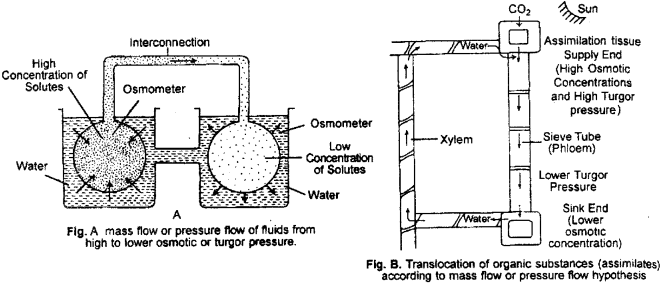
Sieve tube system is fully adapted to mass flow of solutes. Here the vacuoles are fully permeable because of the absence of tonoplast. A continuous high osmotic concentration is present in the mesophyll cells (due to photosynthesis) and storage cells (due to mobilization of reserve food). The organic substances present in them are passed into the sieve tubes (by means of transfer cells). A high osmotic concentration, therefore, develops in the sieve tubes of the source. The sieve tubes absorb water from the surrounding xylem and develop a high turgor pressure (Fig.). It causes the flow of organic solution toward the area of low turgor pressure. A low turgor is maintained in the sink region by converting soluble organic substances into insoluble form. Water passes back into xylem.
(c) Differences between Cyclic and Non-cyclic Photophosphorylation
Cyclic Photophosphorylation:
- It is performed by photosystem I independently.
- An external source of electrons is not required.
- It is not connected with photolysis of water. Therefore, no oxygen is evolved.
- It synthesises only ATP.
- The system does not take part in photosynthesis except in certain bacteria.
- It occurs mostly in stromal or intergranal thylakoids.
- ATP synthesis is not affected by DCMU.
- It is helpful in photosynthesis only in some bacteria.
Non-cyclic Photophosphorylation:
- It is performed by collaboration of both photosystems II and I.
- The process requires an external electron donor.
- It is connected with photolysis of water and liberation of oxygen.
- Noncyclic photophosphorylation is not only connected with ATP synthesis but also production of NADPH.
- The system is connected with C02 fixation.
- It occurs in the granal thylakoids.
- DCMU inhibits noncyclic photophosphorylation.
- It takes part in photosynthesis in all plants including blue-green algae.
Question 4.
(a) Explain in detail the digestion of carbohydrates, as the food passes through the alimentary canal. [4]
(b) Describe step by step what happens in the different phases of the cardiac cycle in human beings. [3]
(c) Write the effects of cytokinins on plants. [3]
Answer:
(a) Digestion of Carbohydrates:
Carbohydrates are of three kinds – polysaccharides, disaccharides, and monosaccharides. Polysaccharides and disaccharides are broken down to monosaccharides during the process of digestion. Starch and cellulose are polysaccharides that are present in cereal grains, potato, tubers and fruits. Sucrose (in cane sugar), maltose (in germinating grains), and lactose (in milk) are disaccharides. Enzymes which act on carbohydrates are called carbohydrases.
1. Digestion of Carbohydrates in the Oral Cavity Action of Saliva. In oral cavity, the food is mixed with saliva. The saliva contains an enzyme called salivary amylase (also called ptyalin) which converts starch into maltose, isomaltose and small dextrins called ‘limit’ dextrins.
![]()
The gastric juice in stomach does not contain carbohydrate-digesting enzyme.
2. Digestion of Carbohydrates in the small intestine
- Action of Pancreatic Juice. The pancreatic juice contains starch digesting enzyme called pancreatic amylase which converts starch into maltose, isomaltose and ‘limit’ dextrins.

- Action of Intestinal Juice. Intestinal juice contains maltase, isomaltase, sucrase, lactase and ‘Limit’ Dextrinase which act as follows :
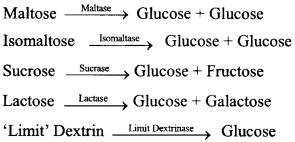
Digestion of Cellulose. The cellulose is not digested by human beings but, however, it is digested by the microorganisms (bacteria and protozoans) in the alimentary canal of herbivorous mammals. These microorganisms ferment cellulose into short-chain fatty acids such as acetic and propionic acid. These acids are then absorbed and utilized by the animal. Cellulose form roughage and helps in digestion process in human beings.
(b) Cardiac Cycle
The cardiac cycle consists of one heartbeat or one cycle of contraction and relaxation of the cardiac muscle. During a heartbeat there is contraction and relaxation of atria and ventricles The , contraction phase is called the systole while the relaxation phase is called the diastole. When both the atria and ventricles are in diastolic or relaxed phase, this is referred to as a joint diastole. During this phase, the blood flows from the superior and inferior venae cavae into the atria and from the atria to the respective ventricles through auriculo-ventricular valves. But there is no flow of blood from the ventricles to the aorta and pulmonary trunk as the semilunar valves remain closed.
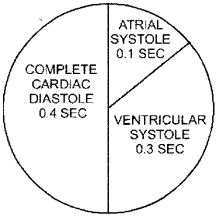
The successive stages of the cardiac cycle arc briefly described below.
- Atrial Systole. The atria contract due to a wave of contraction stimulated by the SA node. The blood is forced into the ventricles as the bicuspid and tricuspid valves are open.
- Beginning of Ventricular Systole. The ventricles contraction is stimulated by the AV node. The bicuspid and tricuspid valves close immediately producing part of the first heart sound.
- Period of Rising Pressure. The pressure in the ventricles rises. The semilunar valves remain closed. The blood does not flow into or out of the ventricles.
- Complete Ventricular Systole. When the ventricles complete their contraction, the blood flows into the pulmonary trunk and aorta as the semilunar valves open.
- Beginning of Ventricular diastole. The ventricles relax and the semilunar valves are closed. This causes the second heart sound.
- Period of Falling Pressure. The pressure within the ventricles continues to decrease. The bicuspid and tricuspid valves still remain closed. Blood flows from the veins into the relaxed atria.
- Complete Ventricular Diastole. The tricuspid and bicuspid valves open when the pressure in the ventricles falls and blood flows from the atria into the ventricles. Contraction of the heart does not cause this blood flow. It is due to the fact that the pressure within the relaxed ventricles is less than that in the atria and veins.
(c) Effects of Cytokinin
- Cell Division. Cytokinins are essential for cytokinesis though chromosome doubling can occur in their absence. In the presence of auxin, cytokinins bring about-division even in permanent cells. Cell division in callus (unorganised, undifferentiated irregular mass of dividing cells in tissue culture) is found to require both the hormones.
- Cell Elongation. Like auxin and gibberellins, cytokinins also cause cell elongation.
- Morphogenesis. Both auxin and cytokinins are essential for morphogenesis or differentiation of tissues and organs. Buds develop when cytokinins are in excess while roots are formed when their ratios are reversed (Skoog and Miller, 1957).
- Differentiation. Cytokinins induce plastid differentiation, lignification and differentiation of interfascicular cambium.
- Senescence (Richmond-Lang Effect). Cytokinins delay the senescence of leaves and other organs.
- Apical Dominance. Presence of cytokinin in an area causes preferential movement of nu-trients towards it. When applied to lateral buds, they help in their growth despite the pres-ence of apical bud. They thus act antagonistically to auxin which promotes apical dominance.
- Seed Dormancy. Like gibberellins, they overcome seed dormancy of various types, including red light requirement of Lettuce and Tobacco seeds.
- Resistance. Cytokinins increase resistance to high or low temperature and disease.
- Phloem Transport. They help in phloem transport.
- Accumulation of Salts. Cytokinins induce accumulation of salts inside the cells.
- Flowering. Cytokinins can replace photoperiodic requirement of flowering in certain cases.
- Sex Expression. Like auxins and ethylene, cytokinins promote femaleness in flowers.
- Parthenocarpy. Crane (1965) has reported induction of parthenocarpy through cytokinin.
Question 5.
(a) Write about the chemical changes which occur during contraction of skeletal muscles. [4]
(b) Draw a neat labelled diagram of the L. S. of a kidney. [4]
(c) What is chloride shift? , [2]
Answer:
(a) Mechanism of Muscle Contraction: The contraction of skeletal muscle includes ultrastructural and biochemical events.
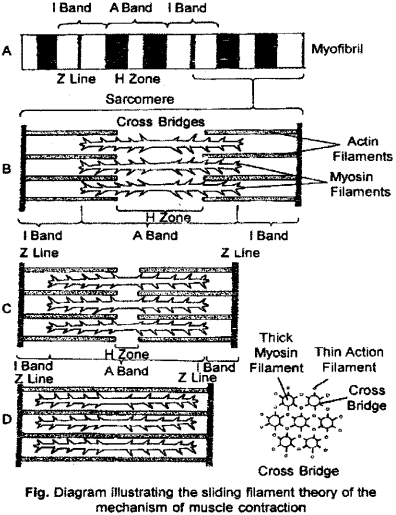
1. Ultrastructural/Physical events (Biophysics of Muscle Contraction).
Myosin and actin are special type of proteins. Myosin forms the thick filaments and the actin forms the thin filaments of the myofibrils of the muscle fibres. The myosin and actin help in the contraction or shortening of muscles by the formation of cross bridges. The cross bridges are the portions of the myosin filaments overlapped by actin filaments.
H. E. Huxley and A. F. Huxley in 1954 proposed a theory to explain the process of muscular contraction. This theory is known as sliding filament theory, which is now generally accepted. This theory states that the actin (thin) filaments slide over the myosin (thick) filaments to penetrate deeper into the A bands in the contracting muscle fibre. The thin filaments meet in the centre of the sarcomere. As such the width of the A band remains constant. However, the I bands shorten and ultimately disappear. This shortens the sarcomere.
As all the sarcomeres of the myofibril shorten simultaneously the muscle fibre shortens. During relaxation the action filaments slide out of A band, thereby lengthening the sarcomere and these crossbridges disappear. This indicates the presence of active sites on the actin filaments into which the cross-bridges temporarily hook to pull the filaments a short distance and then release them. It means that contraction and relaxation of muslces are brought about by the repetitive formation and breakage of crossbridges respectively.
The proteins, troponin and tropomyosin, which are closely associated with actin, are also important in regulating the attachment of actin to the crossbridges.
2. Biochemical Events (Biochemistry of Muscle Contraction). Albert Szent Gyorgyi and other worked out the biochemical events associated with the muscle contraction. These biochemical events are summarised below.
- The nerve impulse stimulates a muscle fibre at the neuromuscular junction or motor end plate, producing acetylcholine.
- Acetylcholine brings out the release of calcium ions from the sarcoplasmic reticulum of the muscle into the interior of muscle fibre which becomes bound with specific sites on troponin of their filament.
- Myosin now binds with actin to form actomyosin in the presence of ATP and calcium ions.

- Energy for muscle contraction is provided by hydrolysis of ATP by myosin ATP- ase enzyme. This hydrolysis produces ADP, inorganic phosphate and energy (used in muscle contraction). Phosphocreatine donates its high energy and phosphate to ADP, producing ATP.
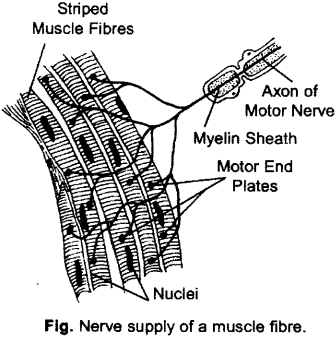
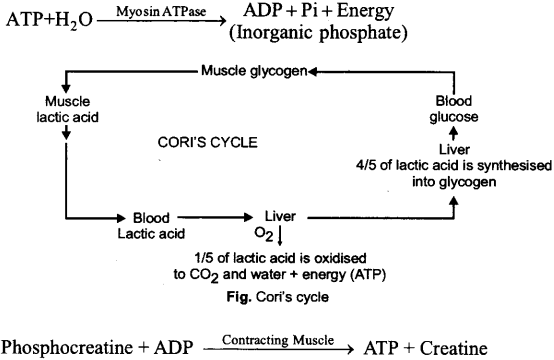
Phosphocreatine serves as an energy source for a few seconds for metabolic processes in the muscle cells to begin to produce greater quantities of ATP. Phosphocreatine is again formed in relaxing muscle by using ATP produced by carbohydrate oxidation.
5. At the end of muscle contraction, the conversion of ADP into ATP takes place. The muscle is rich in glycogen which is broken down into lactic acid through a series of reactions (glycolysis) and liberates energy. Some of this energy is used for the reformation of phosphocreatine and also for the conversion of 4/5th of lactic acid back into glycogen. The l/5th of lactic acid is oxidised to water and carbon dioxide. These reactions taking place in the muscle and liver, are proposed by Cori and Cori, hence known as Cori’s cycle.
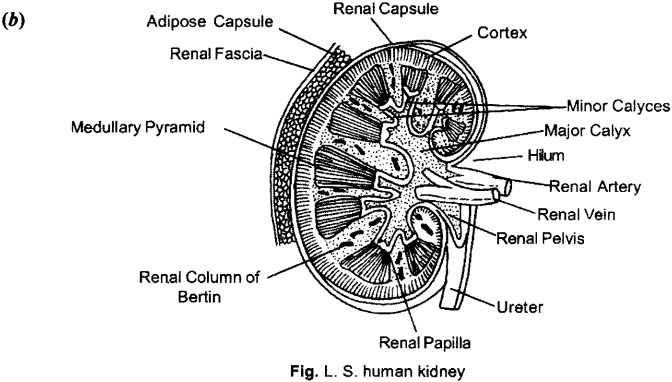
(c) A small amount of bicarbonate ions is transported in the erythrocytes (RBCs), whereas most of them diffuse into the blood plasma to be carried by it.
Exit of bicarbonate ions, from RBCs considerably change ionic balance between the plasma and the erythrocytes. To restore this ionic balance, the chloride ions diffuse from the plasma into the erythrocytes. This movement of chloride ions is called chloride shift ( = Hamburger’s phenomenon). This process maintains an acid-base equilibrium of pH 7.4 for the blood and electrical balance between erythrocytes and plasma.
Question 6.
(a) Explain how the human ear helps in hearing. [4]
(b) Briefly describe the events that occur during the proliferative phase of the menstrual cycle. [3]
(c) Mention the site of secretion and function of the following : [3]
(i) Glucocorticoids
(ii) Calcitonin
(iii) Glucagon
Answer:
(a) Mechanism of hearing : The ear pinna collects and directs the sound waves travelling through air into the external auditory canal. They create vibrations in tympanic membrane (eardrum). These vibrations are transmitted through the chain of ossicles to the perilymph i.e., malleus transmits the message to the adjoining incus. The incus, in turn, transmits the vibrations to stapes. Stapes bone that fits into a membranous opening, the oval window, on the inner wall of the middle ear. Thus, in this process the force of vibration undergoes considerable amplification since the chain of ossicles acts as a lever and the area of the tympanic membrane is much greater than that of the footplate of stapes which increases the force per unit area.
The movement of stapes towards vestibuli, sets up pressure wave in perilymph. This wave passes from vestibule into scale vestibuli, and travels through it to the apex of cochlea. At this point, scala vestibuli is continuous with scala tympani. The pressure wave passes into scala tympani and again traverses the whole length of cochlea. In this way vibrations are set up in the perilymph and through it in the basilar membrane. The basilar membrane moves up and down, distorting hair cells of organ of corti. These distortions generate nerve impulses that travel through auditory nerve to the appropriate part of the brain where the sensation of hearing is felt (recognised).
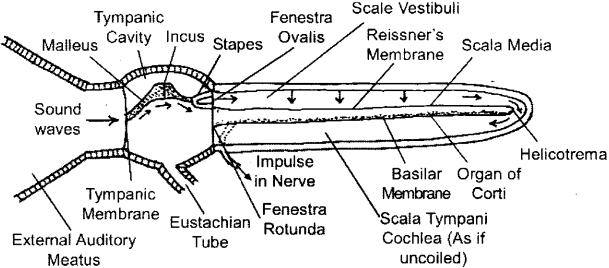
Fig- Schematic representation of the conduction of sound vibrations in the ear.
(b) Proliferative phase : After menstruation, the proliferative phase starts with the growth and proliferation of tissues on the wall of the uterus, fallopian tubes and vagina.
1. Changes in uterus : At the onset of proliferative phase, the endometrium (the mucous membrance of the uterus) is thinnest (about 0.5-1 mm thick) as all superficial layers cast off during the menstrual bleeding. As the proliferative phase progresses, endometrium glands grow in length, epithelial cells of the endometrium proliferate, growth of the endometrium stroma occurs, and the blood vessels grow. Just before ovulation, the endometrium becomes about 3-5 mm thick. The myometrial contractions become more powerful and secretion of the glands of the uterine cervix becomes very thin at the time of ovulation to facilitate the entry of spermatozoa. The uterine changes are due to the rising concentration of estrogen.
2. Changes in the ovary: The ovarian cycle progresses side by side. During the proliferative phase an immature follicle ripens into a Graafian follicle. Since the proliferative phase is associated with a growing follicle in the ovary, this phase is also called follicular phase. The proliferative phase extends for 10 – 12 days and at its end the ovum is ejected (ovulation) from the Graafian follicle of the ovary.
| Hormone | Site of Secretion | Function |
| (i) Glucocorticoids | Adrenal Cortex | Synthesis of carbohydrates from non-carbohydrates e.g., cortisol, degradation of proteins and fats. |
| (ii) Calcitonin | bC cells in the thyroid gland | Regulate calcium and phosphate level in the body. |
| (iii) Glucagon | A-cells in islets of Langerhans in Pancreas | Convert stored glycogen into glucose to maintain its blood level. |
Section – B
(Answer any two questions)
Question 7.
(a) Explain the evolution of the long neck of giraffe according to Darwin and Lamarck. [4]
(b) Explain briefly : [4]
(i) Environmental resistance
(ii) Albinism
(iii) Plant introduction
(iv) Palaeontology
(c) Write two uses of each of the following : [2]
(i) Emblica officinalis
(ii) Adhatoda vesica
Answer:
(a) Lamarck explained that the ancestors of giraffe were bearing a small neck and fore-limbs and were like horses. But as they were living in places with no surface vegetation, they had to stretch their neck and fore-limbs to take the leaves from tall plants for food, which resulted in the slight elongation of these parts. Whatever they acquired in one generation was transmitted to the next generation with the result that a race of long-necked and long fore-limbed animal was developed. The long neck of giraffe, as is found today, can be explained on the basis of Darwinism in the following way:
The giraffes had originally a mixed population with short and long necks. As the leaves on the lower branches of trees became scarce the giraffes were forced to reach the leaves on higher branches of trees. The animals with comparatively longer neck were certainly more fit because they could reach the leaves on higher branches and, therefore, they had better chances of survival. Those with comparatively shorter neck could not reach the higher leaves and hence, die out. So, animals with longer neck were selected by nature. They fed comfortably and reproduced more offspring. Thus, in the course of time and generation after generation, the present-day long-necked giraffes originated by natural selection.
(b) (i) Environmental Resistance: The sum total of inhibitory environmental factors, both biotic end abiotic such as drought, high temperature, shortage of food, shelter, predation, pathogens, diseases etc. which regulate population size and do not permit unlimited growth of population is called environment resistance. Because of environmental resistance, the populations are unable to reach full biotic potential.
(ii) Albinism. The individuals suffering from albinism are called albino. They lack melanin pigment in their skin, hair, iris of eye etc. Such persons are susceptible to bright sun rays and develop eye disorders and skin diseases. Albinism results from inheritance of autosomal gene mutation. Hence the individual lacks the enzyme tyrosinase which is essential for synthesis of melanin. The gene for albinism is a recessive gene (a) which can be expressed only in homozygous (aa) condition. A person with its dominant allele (A) will be normal. The condition is known to affect mammals, fish, birds, reptiles and amphibians. Albinism is a genetic disorder, while the most common term for an organism affected by albinism is ‘albino’. Most organisms with albinism appear white or very pale.
(iii) Plant Introduction : Plant introduction means introducing a plant having desirable characters (e.g., vigorous growth, high yield, disease resistance, etc) from a region or a country where it grows naturally to a region or country where it did not occur earlier.
The adaptation of an individual to a changed environment, or the adjustment of a species or a population to a changed environment over a number of generations is called acclimatization (or acclimation).
Plant introduction has played a significant role in the development of agriculture throughout . the world. Some of the most important commercial crops cultivated extensively in India today are introductions from other countries. For example, Gossypium hirsutum, Cinchona was first introduced into the Nilgris from Peru in 1860. Potato (Solanum tuberosum), chilli (Capsicum annuum), tobacco (Nicotiana tobaccum), guava (Psidium guajava), custard apple (Annona squamosa), cashewnut (Anacardium occidentale) and Papaya (‘Carica papaya) are some of the other examples of crops successfully introduced in India.
Plant introduction can be useful in three different ways :
(a) the introduced material can be used directly by increasing it enmass.
(b) desirable strains can be selected from the introduced material.
(c) the introduced material can be used as a parent for hybridisation with adapted local varieties.
(iv) Palaeontology : It is the study of past life based on the fossil record. The fossils are petrified (turned in to stone) remains or impressions of ancient organisms preserved by natural means in the sedimentary rocks or other media such as amber, asphalt, volcanic – ash, ice, peat bogs, sand and mud. Palaeontology furnishes the most direct and reliable evidence for evolution, as it deals with the actual organisms that lived in the past.
(c)
(i) Emblica officinalis (Euphorbiaceae): Fruits rich in vitamin C, commonly pickled and used as a medicine.
(ii) Adhatoda vesica (Acanthaceae)Used as expectorant in cough, asthma.
Question 8.
(a) Give four applications of tissue culture in crop improvement. [4]
(b) What do you understand by the term population growth ? Give three ways of discouraging population growth. [4]
(c) Define : [2]
(i) Coacervates
(ii) Gene bank
Answer:
(a) Applications of tissue Culture (Micropropagation) :
These are as follows :
- It helps in rapid multiplication of plants.
- A large number of plantlets are obtained within a short period and from a small space.
- Plants are obtained throughout the year under controlled conditions, independent of seasons.
- Sterile plants or plants which cannot maintain their characters by sexual reproduction are multiplied by this method.
- It is an easy, safe and economical method for plant propagation.
- In case of ornamentals, tissue culture plants give better growth, more flowers and less fall-out.
- Genetically similar plants (soma clones) are formed by this method. Therefore, desirable characters (genotype) and desired sex of superior variety are kept constant for many generations.
- The rare plant and endangered species are multiplied by this method and such plants are saved.
(b) Population growth refers to increase in the total number of organisms occupying a certain area.
The various methods to discourage population growth are :
(a) Education : People particularly those in reproductive age group, should be educated about the advantage of a small family, and the consequent benefits to the nation. People should be educated about the affects of overpopulation by the Government agencies mass media such as radio, television, newspaper, magazines, posters and educational institution can play an important role in this campaign. It will certainly help check population growth.
(b) Marriageable age : Raising the age of marriage will decrease reproductive span, can help in reducing population growth. At present, the marriageable age is 18 years for females and 21 years for males. Social change and the increasing aspiration for education and career in women, encourage them to delay marriage and postpone reproduction.
(c) Family planning : The family planning includes many birth control measures. Following family planning methods should be adopted :
- Use of oral contraceptive pills by women.
- Use of vaginal diaphragms.
- Use of intrauterine contraceptive devices (IUCD) like copper-T and loop.
- Surgical techniques of birth control like tubectomy in females and vasectomy in males.
- Medical termination of pregnancy.
- Natural family planning by having intercourse only during safe period or withdrawing penis before ejaculation.
(c) (i) A coacervate was a cluster of the membrane-bound macromolecules of prebiotic soup in the ocean. The macromolecules aggregated and formed small colloidal, masses in the form of insoluble droplets which finally precipitated and formed a larger and denser colloidal system called the coacervates. The coacervates had various macromolecules in different combinations and in specific proportions. Coacervates are considered to be the first living molecules which gave rise to life. Oparin has considered the coacervates as the sole living molecules which gave rise to life on the earth.
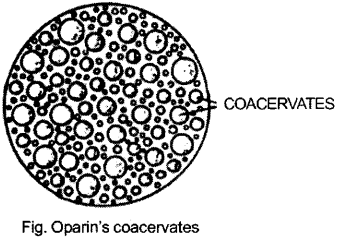
(ii) Gene Banks : They are the institutes that maintain stocks of viable seeds (seed banks), live growing plants (orchards), tissue culture and frozen germplasm with the whole range of genetic variability.
Question 9.
(a) Explain the role of Rh factor in blood incompatibility. [4]
(b) State the main morphological changes that occurred in the ancestors of modem man. [3]
(c) Describe briefly the functions of the following : [3]
(i) CT Scan
(ii) External prosthesis
(iii) Pacemaker
Answer:
(a) Rh blood group incompatibility : Rh factor is an antigen that is found at the surface of RBCs. It was first discovered on the RBCs of Rhesus monkey that is why it is named as Rh factor. Normally, there is no antibody for this antigen. About 85 to 99 per cent population possess this antigen. The persons with this antigen are called Rh +ve and those without it are Rh -ve. Rh factor is expressed by a dominant gene R so Rh +ve persons possess either RR or Rr genotype whereas Rh -ve persons possess rr.
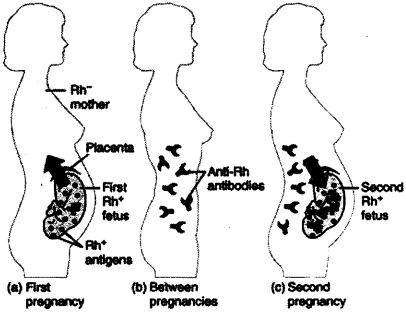
Fig. Rh Factoc incompatibility. Rh positive foetus in Rh negative mother. A. First Pregnancy. B. Mothers body after first pregnancy. More production of AntiRh factors. C. Second pregnancy. RBCs of the foetus are destroyed by Anti Rh factors of the mother.
During inheritance, if both parents are Rh-ve then their offsprings, will also be Rh -ve. A Rh – ve mother having a Rh +ve husband may carry a Rh +ve child. In this case Rh factor produced by child’s blood may enter the stream of mother (at the time of delivery) and cause the production of anti – Rh antibodies in her blood but it results no ill effect. If the same mother conceives again a Rh +ve child second time, then the result may be disastrous. It is because, Rh +ve blood of foetus reacts with anti-Rh antibodies which are already present in her blood finally resulting into a condition called erythroblastosis foetalis.
In blood transfusion, Rh-ve blood can be given safely to a Rh+ve individual. When Rh+ve blood is transfused into Rh-ve individual the recipient develops anti-Rh antibodies in his blood. Usually no complications develops after one transfusion but, if more Rh+ve blood is transfused, the antibodies formed will destroy the RBCs of the Rh +ve blood. To avoid this, Rh factor is determined before such blood transfusions.
(b) The following main morphological changes occurred in the ancestors of modem man.
- Narrowing and elevation of nose.
- Formation of chin.
- Reduction of brow ridges.
- Flattening of face.
- Reduction in body hair.
- Development of curves in the vertebral column for erect posture.
- Formation of bowel-like pelvic girdle with broad ilia (pi. of ilium) in support of viscera.
- Increase in height.
- Attainment of erect posture and bipedal locomotion.
- Enlargement and rounding of cranium.
- Increase in brain size and intelligence.
- Broadening of the forehead and with vertical elevation.
(c)
(i) Computed Scanning (also called computed tomography – (CT): The technique was invented by Sir Godfrey Hounsfield who was awarded a Nobel prize in 1979 for this major achievement. During the last few years, advances in CT technology have led to fast scan times and improved image quality. As a result the scope of CT has widened enormously so that it is now applied to almost any anatomical site.
In CT scanning a computer is used for reconstructing the image made by X-rays instead being recorded directly on the photographic film. The CT scanning technique is used for the diagnosis of the diseases of brain, spinal cord, chest, abdomen and also for the detection of benign and malignant tumours. Thus, it helps to determine the feasibility of operation treatment and also to assess the results of the treatment.
(ii) Prosthesis : Prosthesis is the implantation of an artificial substitute for any body part within the body. It enables the physical handicapped person to live a comfortable and productive life.
Internal prosthesis devices include intraocular lens, dentures. Prosthesis devices also include nose implant for cosmetic reshaping, electronic hearing aids in the ear, artificial arm or leg.
(iii) Pacemaker : It is electronic cardiac-support device that produces rhythmic electrical impulses that take over the regulation of the heartbeat in patients with certain types of -heart disease.
When electrical conduction system is interrupted, as is the case in a number of diseases including congestive heart failure and as an after effect of heart surgery, the condition is called heart block. An artificial pacemaker may be employed temporarily until normal conduction returns or permanently to overcome the block.
The first pacemaker were of a type called asynchronous, or fixed, and they generated regular discharges that overrode the natural pacemaker. The rate of asynchronous pacemakers may be set at the factory or may be altered by the physician, but once set they will continue to generate an electric pulse at regular intervals. Most are set at 70 to 75 beats per minute. .
More recent devices are synchronous, or demand pacemakers that trigger heart contractions only when the normal beat is interrupted. Most pacemakers of this type are designed to generate a pulse when the natural heart rate falls below 68 to 72 beats per minute. These instruments have a sensing electrode that detects the atrial impulse.
Question 10.
(a) Explain the role of a Genetic Counsellor. [4]
(b) Write the causative agent and the main symptoms of the following diseases : [4]
(i) Poliomyelitis
(ii) Typhoid
(iii) Tuberculosis
(iv) Cholera
(c) State two similarities between the chromosomes of man and apes. . [2]
Answer:
(a) The area of health care which provides advice by the expert geneticists on genetic problems is called genetic counselling. It is not a technology but uses biochemical, statistical and physiological techniques to determine chances of occurrence of the actual disease. It thus plays an important role in the welfare of healthy society.
Genetic counselling is advisable for such persons who :
- have a birth defect due to genetic disorder.
- plan to have children after the age of 35.
- have had spontaneous abortions.
- have a close relative with a genetic disorder/disability.
- are parents of a child which has a birth defect or genetic disorder.
- have ethnic disorders like sickle cell anaemia etc. Genetic counselling is helpful to those couples who think that there may be a risk of having a child with a congenital disease. The genetic counsellor then identifies the disorder and advises accordingly. This may allow couples to select the children free from sex-linked abnormalities in the children. Genetic counsellor thus helps in prenatal diagnosis.
Genetic counselling given by the experts is helpful to the prospective parents about the chance of their conceiving children with hereditary disorders. Due to growing knowledge of inheritance, now we have come to know that numerous disabilities have genetic origin. Some of these genetic disorders cannot be predicted easily but other can be. This has enabled us to predict the occurrence of certain genetic disorders such as haemophilia, cystic fibrosis, some kinds of muscular dystrophy etc. if we have proper information about the history of the disorder in the related families. Through genetic counselling, the history of a genetic disorder of the related families is researched and on the basis of this study, the parents are advised on the likelihood of that certain disorder arising in their children.
(b)
| Disease | Causative Agent | Symptoms |
| (i) Poliomyelitis | Antivirus or Poliovirus | Infection of CNS, voluntary muscles fail to work and affected limb or limbs get paralysed, making the patient handicapped, stiffness of neck. |
| (ii) Typhoid | Salmonella typhi | Continued fever, slow pulse, abdominal tenderness, dry coated tongue, soap-like stool |
| (iii) Tuberculosis | Mycobacterium tuberculosis | Fever, general weakness, Loss of appetite, persistent coughing with yellowish blood-stained saliva /sputum, pain in chest, loss of weight |
| (iv) Cholera | Vibrio cholerae | The stool has rice, water appearance, vomiting, acute diarrhoea, in advance stages cholera results in dehydration and loss of minerals |
(c) (i) The somatic number of chromosomes in the cells of human body is 46 and that of great apes is 48 chromosomes. Man is presumed to have descended from a 48 chromosome stock by a centric fusion, however, DNA content is same.
(ii) Comparison of human and ape chromosomes shows that the banding pattern of individual human chromosomes is very similar and in some cases identical to the banding pattern of apparently homologous chromosomes in great apes. The banding pattern of chromosome numbers 3 and 6 of man and chimpanzee shows remarkable similarity in the bands indicating a common origin.
The number and gross morphology of chromosomes in different human races is the same. This shows that morphological differences in the human races are very significant from evolutionary point of view.
